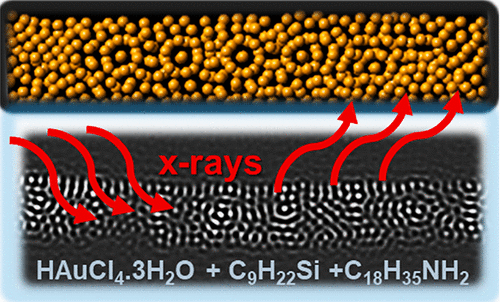Our official English website, www.x-mol.net, welcomes your
feedback! (Note: you will need to create a separate account there.)
Ultrathin Gold Nanowires with the Polytetrahedral Structure of Bulk Manganese
ACS Nano ( IF 15.8 ) Pub Date : 2018-09-10 00:00:00 , DOI: 10.1021/acsnano.8b05036 Jorge A. Vargas 1 , Valeri Petkov 1 , El Said A. Nouh 2 , Raj Kumar Ramamoorthy 2 , Lise-Marie Lacroix 2 , Romuald Poteau 2 , Guillaume Viau 2 , Pierre Lecante 3 , Raul Arenal 4, 5
ACS Nano ( IF 15.8 ) Pub Date : 2018-09-10 00:00:00 , DOI: 10.1021/acsnano.8b05036 Jorge A. Vargas 1 , Valeri Petkov 1 , El Said A. Nouh 2 , Raj Kumar Ramamoorthy 2 , Lise-Marie Lacroix 2 , Romuald Poteau 2 , Guillaume Viau 2 , Pierre Lecante 3 , Raul Arenal 4, 5
Affiliation

|
Despite the intensive interest in thin gold nanowires for a variety of technologically important applications, key details of the mechanism of their formation and atomic-scale structure remain unknown. Here we synthesize highly uniform, very long, and ultrathin gold nanowires in a liquid-phase environment and study their nucleation and growth using in situ high-energy synchrotron X-ray diffraction. By controlling the type of solvents, reducing agents, and gold precursor concentration, it is shown that the nucleation and growth of gold nanowires involve the emergence and self-assembly of transient linear gold complexes, respectively. In sharp contrast with the face-centered-cubic bulk gold, the evolved nanowires are found to possess a tetrahedrally close packed structure incorporating distorted icosahedra and larger size coordination polyhedra of the type observed with the room-temperature phase of bulk manganese. We relate the complexes to synergistic effects between the selected precursor and reducing agents that become appreciable over a narrow range of their molar ratios. We attribute the unusual structural state of gold nanowires to geometrical frustration effects arising from the conflicting tendencies of assemblies of metal atoms to evolve toward attaining high atomic packing density while keeping the atomic-level stresses low, ultimately favoring the growth of cylindrical nanowires with a well-defined diameter and atomically smooth surface. Our work provides a roadmap for comprehensive characterization and, hence, better understanding of 1D metallic nanostructures with an unusual atomic arrangement and may have important implications for their synthesis and performance in practical applications.
中文翻译:

具有体锰多四面体结构的超薄金纳米线
尽管对于各种技术上重要的应用都对薄金纳米线有浓厚的兴趣,但其形成机理和原子尺度结构的关键细节仍然未知。在这里,我们在液相环境中合成了高度均匀,非常长且超薄的金纳米线,并使用原位研究了它们的成核和生长高能同步加速器X射线衍射。通过控制溶剂,还原剂和金前驱体的类型,表明金纳米线的成核和生长分别涉及瞬态线性金络合物的出现和自组装。与以面心立方大块金形成鲜明对比的是,发现进化出的纳米线具有四面体紧密堆积的结构,该结构结合了扭曲的二十面体和较大尺寸的配位多面体(在大块锰的室温下观察到的类型)。我们将络合物与选定的前体和还原剂之间的协同效应联系起来,这些协同作用在其摩尔比的狭窄范围内变得可观。我们将金纳米线的异常结构状态归因于几何挫折效应,这种几何挫折效应是由金属原子的组装体相互冲突的趋势演变而来的,即它们在保持较低的原子能级应力的同时向着获得高原子堆积密度的方向发展,最终有利于圆柱纳米线的良好生长。定义的直径和原子光滑的表面。我们的工作为全面表征提供了路线图,因此,可以更好地理解具有异常原子排列的一维金属纳米结构,并且可能对其在实际应用中的合成和性能产生重要影响。最终有利于生长具有明确定义的直径和原子光滑表面的圆柱形纳米线。我们的工作为全面表征提供了路线图,因此,可以更好地理解具有异常原子排列的一维金属纳米结构,并且可能对其在实际应用中的合成和性能产生重要影响。最终有利于生长具有明确定义的直径和原子光滑表面的圆柱形纳米线。我们的工作为全面表征提供了路线图,因此可以更好地理解具有异常原子排列的一维金属纳米结构,并且可能对其合成和实际应用中的性能产生重要影响。
更新日期:2018-09-10
中文翻译:

具有体锰多四面体结构的超薄金纳米线
尽管对于各种技术上重要的应用都对薄金纳米线有浓厚的兴趣,但其形成机理和原子尺度结构的关键细节仍然未知。在这里,我们在液相环境中合成了高度均匀,非常长且超薄的金纳米线,并使用原位研究了它们的成核和生长高能同步加速器X射线衍射。通过控制溶剂,还原剂和金前驱体的类型,表明金纳米线的成核和生长分别涉及瞬态线性金络合物的出现和自组装。与以面心立方大块金形成鲜明对比的是,发现进化出的纳米线具有四面体紧密堆积的结构,该结构结合了扭曲的二十面体和较大尺寸的配位多面体(在大块锰的室温下观察到的类型)。我们将络合物与选定的前体和还原剂之间的协同效应联系起来,这些协同作用在其摩尔比的狭窄范围内变得可观。我们将金纳米线的异常结构状态归因于几何挫折效应,这种几何挫折效应是由金属原子的组装体相互冲突的趋势演变而来的,即它们在保持较低的原子能级应力的同时向着获得高原子堆积密度的方向发展,最终有利于圆柱纳米线的良好生长。定义的直径和原子光滑的表面。我们的工作为全面表征提供了路线图,因此,可以更好地理解具有异常原子排列的一维金属纳米结构,并且可能对其在实际应用中的合成和性能产生重要影响。最终有利于生长具有明确定义的直径和原子光滑表面的圆柱形纳米线。我们的工作为全面表征提供了路线图,因此,可以更好地理解具有异常原子排列的一维金属纳米结构,并且可能对其在实际应用中的合成和性能产生重要影响。最终有利于生长具有明确定义的直径和原子光滑表面的圆柱形纳米线。我们的工作为全面表征提供了路线图,因此可以更好地理解具有异常原子排列的一维金属纳米结构,并且可能对其合成和实际应用中的性能产生重要影响。








































 京公网安备 11010802027423号
京公网安备 11010802027423号